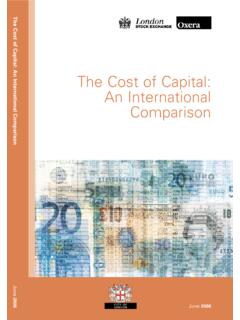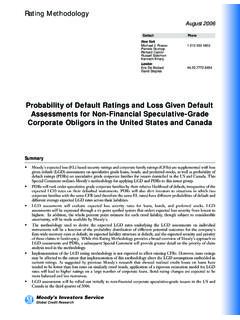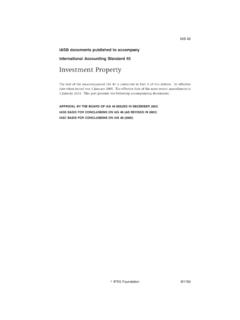Transcription of Causes and Consequences of Choosing Historical Cost versus ...
1 Causes and Consequences of Choosing Historical Cost versus Fair Value Karl A. Muller, III Pennsylvania State University Edward J. Riedl * Harvard Business School Thorsten Sellhorn Ruhr-Universit t Bochum March 2008 ABSTRACT: We examine the Causes and Consequences of investment property firms choice to use the Historical cost or fair value model to account for their primary asset, real estate. Our examination exploits the European Union s adoption of International Financial Reporting Standards, which require firms to make this choice under ias 40 investment property . We hypothesize and find evidence that firms are more likely to choose the fair value model when the firm s pre-IFRS domestic standards permitted or required fair values on the balance sheet, when ownership is more dispersed, and when the firm exhibits a greater commitment to reporting transparency.
2 We also find some evidence of opportunism, as firms adopting the fair value model report larger fair value gains than comparable as if figures for firms Choosing the cost model. Finally, we find limited evidence that firms Choosing the fair value model have lower information asymmetry and greater liquidity than those Choosing the cost model. Overall, our results reveal the occurrence, Causes , and Consequences of variation in firms reporting choices when differing accounting treatments are permitted. Key Terms: Fair value, accounting choice, IFRS, real estate, investment property , ias 40 JEL Classification: M41, G15, G38 Acknowledgements: We appreciate useful discussion and data assistance from the following persons and their affiliated institutions: Hans Gronloh and Laurens te Beek of EPRA; Simon Mallinson of IPD; and Michael Grupe and George Yungmann of NAREIT.
3 We also thank Francois Brochet, Fabrizio Ferri, Holly Skaife, and seminar participants at Boston University and the Harvard Business School for helpful comments. Finally, we thank Susanna Kim and Erika Richardson for research assistance, and James Zeitler for data assistance. * Corresponding author: Harvard Business School Morgan Hall 365 Boston, MA 02163 Phone: Fax: Email: 2 Causes and Consequences of Choosing Historical Cost versus Fair Value ABSTRACT: We examine the Causes and Consequences of investment property firms choice to use the Historical cost or fair value model to account for their primary asset, real estate. Our examination exploits the European Union s adoption of International Financial Reporting Standards, which require firms to make this choice under ias 40 investment property .
4 We hypothesize and find evidence that firms are more likely to choose the fair value model when the firm s pre-IFRS domestic standards permitted or required fair values on the balance sheet, when ownership is more dispersed, and when the firm exhibits a greater commitment to reporting transparency. We also find some evidence of opportunism, as firms adopting the fair value model report larger fair value gains than comparable as if figures for firms Choosing the cost model. Finally, we find limited evidence that firms Choosing the fair value model have lower information asymmetry and greater liquidity than those Choosing the cost model. Overall, our results reveal the occurrence, Causes , and Consequences of variation in firms reporting choices when differing accounting treatments are permitted.
5 3 Causes and Consequences of Choosing Historical Cost versus Fair Value 1. Introduction The required adoption of International Financial Reporting Standards (IFRS) in the European Union (EU) effective January 1, 2005 resulted in a number of significant changes in how firms report their financial results. IFRS have been criticized both for the flexibility afforded under the standards, as well as the encroachment of the fair value paradigm. This paper examines both issues by investigating European investment property firms choice of cost versus fair value models to report their primary assets (real estate), a choice afforded under International Accounting Standard (IAS) 40, investment property .
6 The adoption of IFRS, and especially the application of ias 40 in the European investment property industry, presents a unique research opportunity. Upon adoption of IFRS, publicly-traded firms in the EU ceased application of domestic accounting standards in their consolidated accounts. This change was significant, as many of the accounting treatments and disclosures required under IFRS differed from those under the previously-applied domestic standards. Within the real estate industry, the domestic accounting standards required that investment property assets be accounted for either under the cost model ( , France, Germany, and Italy) or the revaluation model ( , the UK). Under the cost model, investment property is reported at depreciated Historical cost subject to impairment testing.
7 Under the revaluation model, investment property is reported at fair value on the balance sheet; however, changes in fair value bypass the income statement, and are recognized directly in equity. ias 40 substantially changed the financial reporting for this industry in the following ways. First, it eliminated the revaluation model as an allowable choice to account for investment 4property assets, despite considerable support from industry constituents that this was the appropriate accounting treatment (see comment letters for the relevant exposure draft, IASC 2000). Second, it introduced the fair value model, which was not permitted under the pre-IFRS domestic standards of most European countries.
8 Under the fair value model, investment property is reported at fair value on the balance sheet, and all changes in fair value flow through the income statement. This latter requirement would likely introduce substantial volatility in reported net income, in part owing to the cyclical nature of the real estate industry. Further, ias 40 was significant, as it represented the first time the fair value model was adopted for long-lived non-financial Finally, the standard allowed firms to choose between the cost and fair value models to report their investment property in their primary financial statements; however, firms Choosing the cost model must also disclose fair values in the footnotes. We exploit this setting to provide evidence on the Causes underlying a firm s decision to apply the cost versus fair value model.
9 We hand-collect data from the financial statements of 133 publicly-traded European investment property firms, for which property reported under ias 40 are significant assets. Consistent with predictions, empirical results reveal that a firm s previous financial reporting, ownership structure, commitment to transparency, and incentives to report higher income all affect the model choice. In particular, firms Choosing the fair value model under ias 40 are more likely to have pre-IFRS domestic accounting requirements incorporating elements of fair value reporting (through the revaluation model), and are more likely to have dispersed ownership. In addition, firms Choosing the fair value model are more likely to have signaled a commitment to reporting transparency via other reporting decisions, such as the use of an external appraiser to provide fair value estimates or voluntary adoption of 1 IFRS allow fair value reporting of non-financial assets on the balance sheet under IAS 16 ( property , Plant and Equipment); however, this is under the revaluation model.
10 IFRS also require the fair value model under IAS 39 (Financial Instruments: Recognition and Measurement), but this is only for certain financial assets and liabilities. 5 IFRS prior to the mandatory application in Europe. Finally, we present some evidence that firms choose the fair value to maximize reported net income, as the recognized fair value gains on investment properties for firms Choosing the fair value model are larger than comparable as if gains that would have been reported by firms Choosing the cost model. Overall, our results are consistent with firms making reporting decisions reflective of cultural influences ( , the effect of pre-IFRS domestic GAAP), institutional characteristics ( , the firm s ownership), and the reporting preferences ( , commitment to transparency).












